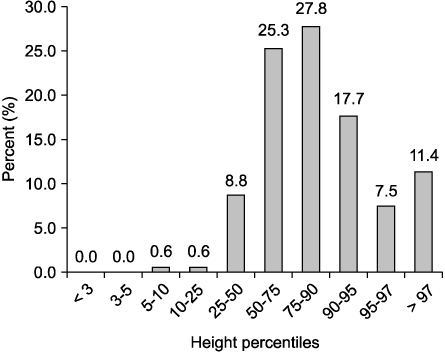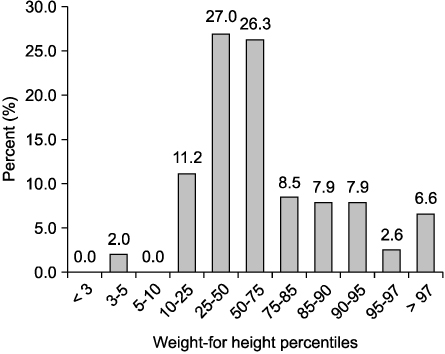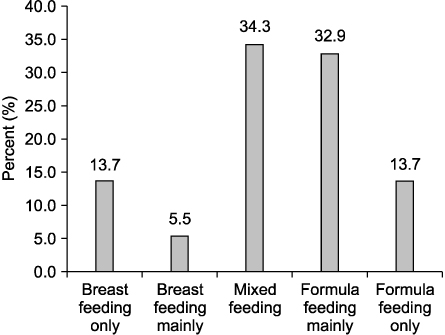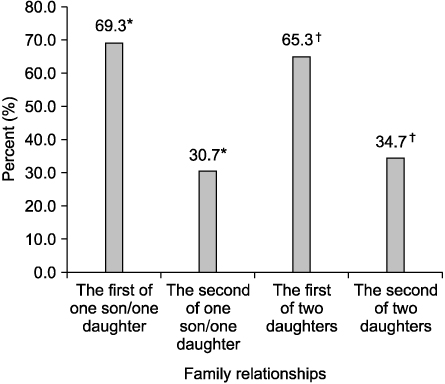Pediatr Gastroenterol Hepatol Nutr.
2012 Sep;15(3):175-182.
A Clinical Study of the Relationship between Obesity and Pubertal Development in Girls
- Affiliations
-
- 1Department of Pediatrics, Hallym University Medical Center, Chuncheon, Korea. ohphilia@unitel.co.kr
Abstract
- PURPOSE
Recently, public interest in obesity and earlier pubertal development has been increasing. The purpose of this study was to analyze the relationship between obesity and pubertal development in girls.
METHODS
A total of 158 girls presenting with earlier pubertal development from July 2008 to June 2010 were included in the study. Their mean age was 8.27+/-1.3 years and the mean bone age advancement was 1.86+/-0.3 years.
RESULTS
Based on weight-for-height percentiles, their obesity rate was 9.2% and overweight rate was 15.8%. However, for body mass index (BMI), the result was a bit different; with an obesity rate of 13.2% and overweight rate of 24.3%. About 40% of the girls had a family history of early maturation. Among them, 25.7% had a maternal history, 4.6% paternal and 7.2% both. However, 60% of them had no family history. We then classified these girls into families with one son and one daughter, and those with two daughters. In one-son/one-daughter families, 69.3% were the first children and 30.7% were second. In two-daughter families, 65.3% were the first and 34.7% were second. We found that 67.5% had a history of taking herbal medicine.
CONCLUSION
The obesity and overweight rates in girls with earlier pubertal development were higher than those of normal girls, but with a small discrepancy between weight-for-height percentile and BMI-based results. Furthermore, taking herbal medicine seems to be a potential factor for earlier pubertal development in Korea.
Keyword
MeSH Terms
Figure
Reference
-
1. Na JM, Lee YJ, Kim MS, Lee DY, Yeo CY, Kim CJ, et al. Causes of precocious puberty: multicenter study in Honam Area. J Korean Soc Pediatr Endocrinol. 2009. 14:30–37.2. Park MJ. Update in the etiology and treatment of sexual precocity. Korean J Pediatr. 2006. 49:718–725.
Article3. Kaplowitz P. Precocious puberty: update on secular trends, definitions, diagnosis, and treatment. Adv Pediatr. 2004. 51:37–62.4. Paik KH, Jin DK. Etiology and age incidence of precocious puberty. J Korean Soc Pediatr Endocrinol. 2002. 7:199–205.5. Davison KK, Susman EJ, Birch LL. Percent body fat at age 5 predicts earlier pubertal development among girls at age 9. Pediatrics. 2003. 111:815–821.
Article6. Martí-Henneberg C, Vizmanos B. The duration of puberty in girls is related to the timing of its onset. J Pediatr. 1997. 131:618–621.
Article7. Kaplowitz PB, Slora EJ, Wasserman RC, Pedlow SE, Herman-Giddens ME. Earlier onset of puberty in girls: relation to increased body mass index and race. Pediatrics. 2001. 108:347–353.
Article8. Papadimitriou A, Nicolaidou P, Fretzayas A, Chrousos GP. Constitutional advancement of growth, early growth acceleration, predicts early puberty and childhood obesity. J Clin Endocrinol Metab. 2010. 95:4535–4541.
Article9. Ellis BJ, Garber J. Psychosocial antecedents of variation in girls' pubertal timing: maternal depression, stepfather presence, and marital and family stress. Child Dev. 2000. 71:485–501.
Article10. Frisch RE, McArthur JW. Menstrual cycles: fatness as a determinant of minimum weight for height necessary for their maintenance or onset. Science. 1974. 185:949–951.
Article11. Bellizzi MC, Dietz WH. Workshop on childhood obesity: summary of the discussion. Am J Clin Nutr. 1999. 70:173S–175S.
Article12. Franklin MF. Comparison of weight and height relations in boys from 4 countries. Am J Clin Nutr. 1999. 70:157S–162S.
Article13. Moon KR. Diagnosis and treatment of childhood obesity. Korean J Pediatr Gastroenterol Nutr. 1999. 2:8–20.
Article14. Rho YI, Kim KH, Yang ES, Park YB, Park SK, Park J, et al. Prevalence of obesity and its relationship to diet on elementary students. Korean J Pediatr Gastroenterol Nutr. 2000. 3:181–187.
Article15. Oh K, Jang MJ, Lee NY, Moon JS, Lee CG, Yoo MH, et al. Prevalence and trends in obesity among Korean children and adolescents in 1997 and 2005. Korean J Pediatr. 2008. 51:950–955.
Article16. Wang Y. Is obesity associated with early sexual maturation? A comparison of the association in American boys versus girls. Pediatrics. 2002. 110:903–910.
Article17. Lee JM, Appugliese D, Kaciroti N, Corwyn RF, Bradley RH, Lumeng JC. Weight status in young girls and the onset of puberty. Pediatrics. 2007. 119:e624–e630.
Article18. Ong KK, Emmett P, Northstone K, Golding J, Rogers I, Ness AR, et al. Infancy weight gain predicts childhood body fat and age at menarche in girls. J Clin Endocrinol Metab. 2009. 94:1527–1532.
Article19. Laron Z. Is obesity associated with early sexual maturation? Pediatrics. 2004. 113:171–172.
Article20. Lee YJ, Jin YR, Lim WC, Park WK, Cho JY, Jang S, et al. Ginsenoside-Rb1 acts as a weak phytoestrogen in MCF-7 human breast cancer cells. Arch Pharm Res. 2003. 26:58–63.
Article21. Ji SM, Lee YJ. Estrogen, androgen and retinoic acid hormone activity of ginseng total saponin. J Ginseng Res. 2003. 27:93–97.
Article22. Jung JH, Lee K. A survey on mothers' perception of breastfeeding. J Korean Pediatr Soc. 1999. 42:1050–1055.23. Park EY, Cho SJ, Lee K. Current understanding and practices of breast feeding by mothers. Korean J Pediatr. 2005. 48:1162–1165.24. Gilka J, Gajduskova V, Malikova M, Masek J, Docekalova H, Hais R, et al. Foreign substances in the meat and organs of bulls and pigs fed with pastes made from household and food industry waste in addition to pastes made from poultry droppings. Vet Med (Praha). 1987. 32:721–730.25. Stoll BA. Western diet, early puberty and breast cancer risk. Breast Cancer Res Treat. 1998. 49:187–193.
Article26. Rogers IS, Northstone K, Dunger DB, Cooper AR, Ness AR, Emmett PM. Diet throughout childhood and age at menarche in a contemporary cohort of British girls. Public Health Nutr. 2010. 13:2052–2063.
Article27. Renu G, Suzanne MS. BCERF Fact Sheet No. 37. Consumer concerns about hormones in food. 2000. New York: Cornell University Sprecher Institute for Comparative Cancer Research.28. Towne B, Czerwinski SA, Demerath EW, Blangero J, Roche AF, Siervogel RM. Heritability of age at menarche in girls from the Fels longitudinal study. Am J Phys Anthropol. 2005. 128:210–219.
Article29. Walvoord EC. The timing of puberty: is it changing? does it matter? J Adolesc Health. 2010. 47:433–439.
Article30. Huh K, Park MJ. Questionnaire-based analysis of growth-promoting attempts among children visiting a university growth clinic. Korean J Pediatr. 2009. 52:576–580.
Article31. Jeong MJ, Gok SY, Lee SY. Pilot study of effect to the growth after the administration of herbal medicine to the prepuberty children. J Korean Oriental Pediatrics. 2008. 22:25–34.32. Ahn YJ. A study of elementary school pupils using traditional herbal medicines. Korean J Pediatr. 2007. 50:381–385.
Article33. Ahn YJ, Kim EY, Moon KR. A study on the utilization of complementary and alternative medicine for elementary children. Korean J Pediatr. 2009. 52:1103–1108.
Article34. Lee MC, Kim MJ, Choi MJ, Cheuh HW, Yoo JH. Complementary therapies and perceptions of growth in parents and children visiting the growth clinic. J Korean Soc Pediatr Endocrinol. 2008. 13:73–80.35. Warren MP. The effects of exercise on pubertal progression and reproductive function in girls. J Clin Endocrinol Metab. 1980. 51:1150–1157.
Article36. Theintz GE. Endocrine adaptation to intensive physical training during growth. Clin Endocrinol (Oxf). 1994. 41:267–272.
Article37. Stafford DE. Altered hypothalamic-pituitary-ovarian axis function in young female athletes: implications and recommendations for management. Treat Endocrinol. 2005. 4:147–154.
Article
- Full Text Links
- Actions
-
Cited
- CITED
-
- Close
- Share
- Similar articles
-
- Childhood Obesity and Pubertal Development
- Slower progression of central puberty in overweight girls presenting with precocious breast development
- Abnormal pubertal development in Korean adolescent girls
- A study of factors influencing advanced puberty
- The impact of obesity on hyperandrogenemia in Korean girls





